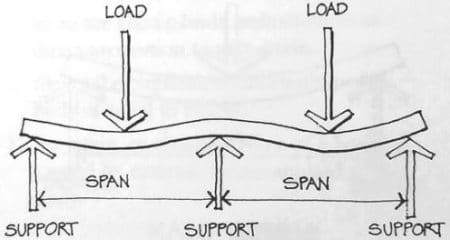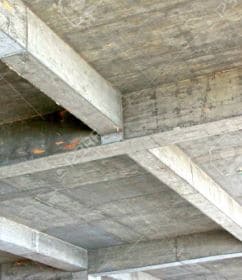What is a Beam and Different Types of Beams used in Construction
What is a Beam and Different Types of Beams used in Construction
What is a Beam?
Beam is defined as the structural member which is used to bear different loads. It resists the vertical loads, shear forces and bending moments.
Beams are structural elements that mainly resist loads applied laterally to the axis of the shaft. Its mode of deflection is primarily by bending.
The load applied to the beam result in reaction forces on the beam’s support factors. The total impact of all of the forces acting on the beam is to supply shear forces and bending moments inside the beam. That, in turn, induces inner stresses, traces, and deflections of the beam.
Beams are characterized by their support, profile (shape of move-phase), equilibrium conditions, length, and materials.
Beams are traditionally descriptions of constructing or civil engineering structural elements. However, any systems inclusive of automobile vehicle frames, plane components, system frames, and other mechanical or structural structures have beam systems designed to hold lateral.
Beams can be of steel, wood, prestressed concrete, reinforced concrete, plastics, and even masonry work with steel reinforced in the bond between bricks.
To reduce the weight, these beams of metal are often formed as an I or other particular shape having a thin vertical web and thicker horizontal flanges where most of the strain
Types of Beams in Construction
Different types of beams are used in construction of building and structures. These are horizontal structural element that withstand vertical loads, shear forces and bending moments. Beams transfer loads imposed along their length to their end points to walls, columns, foundations, etc.
In this article, different types of beams used in building construction will be discussed based on their manner of support, cross-section shape (profile), length, and their material.
Types of Beams in Constructions
There are different types of beams which are classified based on the following conditions
- Based on Support Conditions
- Based on Construction Materials
- Based on Cross-Section Shapes
- Based on Geometry
- Based on Equilibrium Condition
- Based on Method of Construction
Based on Support Conditions
Simply Supported Beam
It is the one of the simplest structural elements that both ends are rest on supports but are free to rotate. It contains pinned support at one end and roller support at the other end. On the basis of assign load, it sustains shearing and bending.

Simply supported beam
Fixed Beam
It is supported at both ends and fixed to resist rotation. It is also called a built-in beam. The fixed ends produce fixing moments other than the reactions.

Fixed Beam
Cantilever Beam
If a beam is fixed at one end and set to be free at the end, it is termed as cantilever beam. The beam distribute the load back to the support where it is forced against with a moment and shear stress. Cantilever beams allow the creation of a bay window, balconies, and some bridges.

Cantilever beam
Continuous Beam
A continuous beam has more than two supports distributed along its entire length.

Continuous beam
Based on Construction Materials
Reinforced Concrete Beams
It is constructed from concrete and reinforcement as shown in Fig. 5.
Steel Beams
It is constructed from steels and used in several applications.

Steel beam
Timber beams
This type of beam is constructed from timber and used in the past, but its application is significantly declined now.

Timber Beam
Composite Beams
Composite beams are constructed from two or more different types of materials such as steel and concrete, and various valid cross sections have been utilized as shown in fig.8.

Composite beam
Based on Cross-Section Shapes
Several cross sectional shapes of beams are available and used in different parts of of structures. These beams can be constructed from reinforced concrete, steel, or composite materials:
Reinforced concrete cross sectional shapes include:
Rectangular beam
This type of beam is widely used in the construction of reinforced concrete buildings and other structures.

Rectangular Reinforced concrete beam
T-section beam
This type of beam is mostly constructed monolithically with reinforced concrete slab. Sometimes, Isolated T-beam are constructed to increase the compression strength of concrete.
Added to that, inverted T-beam can also be constructed according to the requirements of loading imposed.


Inverted T-beam
L-section beam
This type of beam is constructed monolithically with reinforced concrete slab at the perimeter of the structure, as illustrated in below
Steel cross sectional shapes include:
There are various steel beam cross sectional shapes. Each cross sectional shape offer superior advantages in a given conditions compare with other shapes.
Square, rectangular, circular, I-shaped, T-shaped, H-shaped,C-shaped, and tubular are examples of beam cross sectional shapes constructed from steel.

Steel beam cross sectional shapes
Different types of beams based on cross sectional shapes constructed from composite materials are shown below.
Based on Geometry
Straight beam
Beam with straight profile and majority of beams in structures are straight beams.

straight beam
Curved beam
Beam with curved profile, such as in the case of circular buildings.

Curved beam
Tapered beam
Beam with tapered cross section.

Tapered beam
5. Based on Equilibrium Condition
Statically determinate beam
For a statically determinate beam, equilibrium conditions alone can be used to solve reactions, i.e the number of unknown reactions are equal to the the number of equations.

Based on Method of Construction
Cast In-situ Concrete Beam
This type of beam is constructed on project site. so, forms are initially fixed then fresh concrete is poured and allowed to be hardened. Then, loads will be imposed.

Cast in situ beam
Precast Concrete Beam
This type of beam is manufactured in factories. So, the construction condition is more controllable compare with on-site construction. Consequently, the quality of concrete of the beam will be greater. Various cross sectional shapes can be manufactures such as T- beam, Double T-beam, Inverted T-beam and many more.

Precast concrete beam
Prestressed Concrete Beam
This type of beam constructed by stressing strands prior to applying loads on the beam. Pre-tensioned Concrete beam and post-tensioned Concrete Beam are variations of pre-stressed concrete beam.

Pre-stressed concrete beam
Girder Beam
Girders are types of beams that are normally made from steel type sections. Girders can hold quite heavy loads without a problem.



